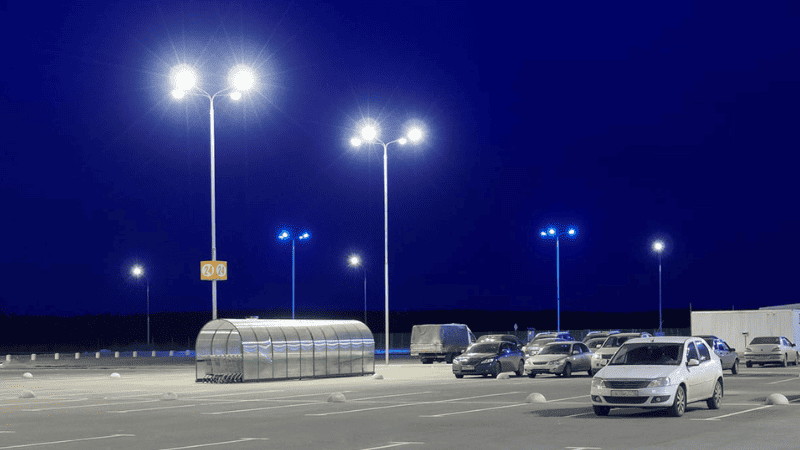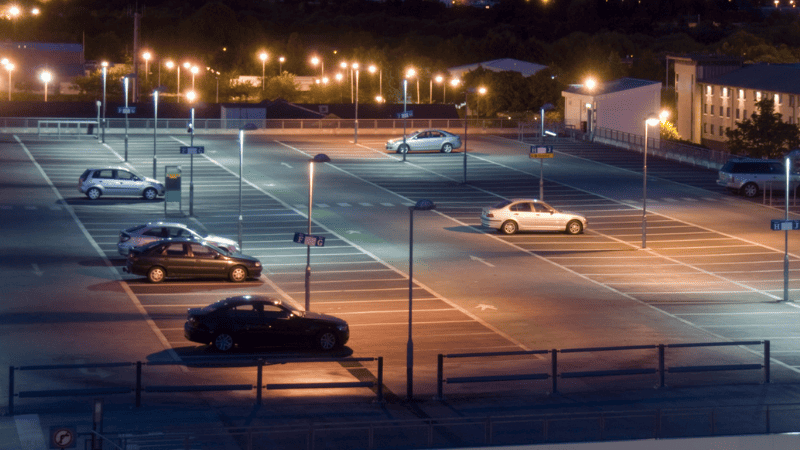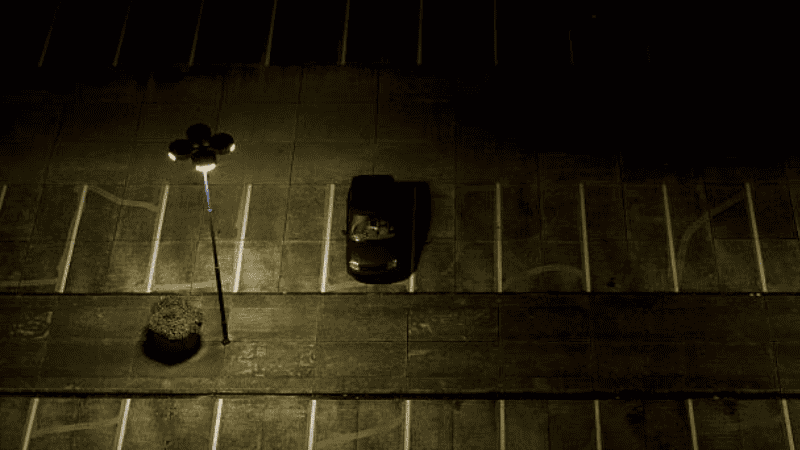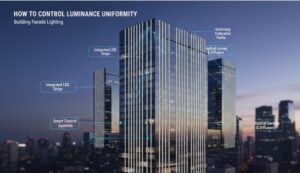Did you know that 11% of the crime rates occur in parking lots and garages? Safety in parking lots is essential for both drivers and pedestrians. A well-lit parking lot can help prevent crime, improve visibility, and enhance the overall safety of the area. According to a study, improved lights prevent up to 21% of incidents in parking lots.
Setting LED parking lot lights can improve the safety of your property while also being energy efficient. Besides that, investing in good-quality parking lot lighting makes good business sense and improves overall aesthetics. After all, a well-lit parking lot can attract more customers and tenants, making it a win-win situation for everyone.

However, setting up parking lot lights requires knowledge about legal requirements, placement, and lighting output. If you plan to install LED parking lot light or upgrade your existing light-emitting diode light, this tutorial will guide you through the necessary steps to know parking lot light requirements.
Importance of Parking Lot Lighting
When it comes to managing a property, parking lot lighting is often overlooked, but it shouldn’t be. A well-lit parking lot portrays a secure and professional image of your property, making it attractive to prospective customers or tenants. The ambiance created by the lighting increases the perception of safety and can significantly impact the customers’ impression of your business or property.
Visibility is another crucial factor. Effective parking lot lighting ensures clear visibility, allowing drivers to spot any potential obstacles and pedestrians to navigate safely. It also makes surveillance more effective, as some CCTV cameras require sufficient light for clear images. This visibility is not just about brightness but also about minimizing dark corners and shadows where intruders might hide.
Parking lot lighting also contributes to the overall appeal of your property. The right choice of lights and their strategic placement can highlight architectural details, signage, and landscaping. Proper lighting can also guide traffic flow and mark pedestrian walkways, contributing to the overall organization and seamless functioning of the parking lot.
Ask For Free Quote
Let us Respond Promptly for your Needs :)
Delving into Parking Lot Light Design and Standards
The design and layout of your parking lot lighting play an important role in the effectiveness and efficiency of the overall system. To ensure adequate illumination, the height, positioning, and spacing of the lights must be carefully considered.
Parking lot lighting standards, set by organizations like the Illuminating Engineering Society (IES) and OSHA Lighting Standards, ensure adequate light levels for safety and visibility. These standards consider light pollution and energy efficiency, prioritizing environmental sustainability.
Ensuring compliance with these standards is not just about meeting a legal obligation; it also directly impacts the safety and functionality of your parking lot. However, complying with these standards doesn’t mean you have to compromise on the aesthetics. Factors like fixture design, light color temperature, and direction can be customized to suit your property’s unique requirements.
It’s important to note that your local government may also have specific codes and ordinances to be followed for parking lot lighting. It’s essential to check with your city or county regulations before starting any installation or upgrades.
3 Steps to Know Parking Lot Light Requirements
Let’s dive into the steps to know the parking lot light requirements for your property:
1. Safety Standard Review
The first step in understanding parking lot light requirements is to review safety standards. Safety is paramount, and you must be familiar with the lighting standards set by national organizations such as the Illuminating Engineering Society (IES) and the Occupational Safety and Health Administration (OSHA).
Below is the comparison table to highlight the key differences between OSHA safety standards and IES lighting standards:
|
Aspect |
OSHA Safety Standards |
IES Lighting Standards |
|
Scope |
Focused on workplace safety |
Focused on lighting design |
|
Regulatory Authority |
Federal (U.S.) |
Non-regulatory, voluntary |
|
Purpose |
Ensures worker safety |
Ensures quality lighting |
|
Applicability |
Industrial, commercial, etc. |
Lighting industry |
|
Content |
Covers a wide range of safety aspects, including equipment safety, hazard communication, personal protective equipment, etc. |
Focuses on lighting design principles, performance, and measurement |
|
Enforcement |
Enforced through inspections, citations, and penalties |
Self-enforced by lighting professionals and organizations |
|
Specific Standards |
Examples include OSHA 29 CFR 1910 (General Industry) and OSHA 29 CFR 1926 (Construction) standards |
IES provides standards such as the RP (Recommended Practice) series for lighting design |
|
Safety Emphasis |
Emphasizes preventing accidents, injuries, and fatalities in the workplace |
Emphasizes achieving high-quality, efficient, and aesthetically pleasing lighting |
|
Consequences of Non-Compliance |
OSHA violations can result in fines and penalties |
Non-compliance with IES standards may lead to suboptimal lighting performance, but there are no legal consequences |
OSHA and IES rules outline the minimum light levels required for different areas of your parking lot. For example, entrances and exits, pedestrian areas, and general parking areas have different lighting requirements. They also consider factors like glare control and uniformity of light distribution.
2. Local Lighting Ordinances
Ordinances are the laws that govern your property’s location and can vary from state to state or county to county. They often detail the amount of light permitted (measured in foot candles) in different areas of your property. They may also contain specific details on light pollution control and energy conservation.
To give you an idea, let’s check out a couple of examples:
- New York City has specific light pollution control regulations. They require outdoor lighting to minimize glare, obtrusive lighting, and impacts on the night sky. For parking lot lighting, the standards state that light fixtures must be fully shielded and aimed toward the ground to ensure no upward lighting.
- In LA, outdoor lighting must be designed to maximize energy efficiency and minimize light trespass, glare, and excess brightness. For instance, parking lot lights must not exceed 15 feet in height and must have full cutoff fixtures to prevent light pollution. The city also requires that outdoor lighting be dimmed or turned off during non-operational hours to conserve energy.

Understanding these local ordinances is critical in knowing what’s allowed and not when setting up your parking lot lights. You can usually find this information on your city or county’s official website or by contacting your local government office.
3. Design Requirements
Designing your parking lot lighting involves several considerations to ensure optimal illumination, safety, and aesthetics. Here are some key factors to consider:
- The area of the parking lot: The size and layout of your parking lot directly impact the number and placement of lights. A larger area might require more high-intensity lights, and the shape may dictate non-traditional configurations. Always aim for uniform lighting to minimize shadows and dark spots.
- Parking lot light fixture style: There are various types of light fixtures available for parking lots, each with its own unique features and benefits. For example, pole-mounted lights provide ample lighting coverage, while wall-mounted fixtures are better for smaller areas. LED parking lot lights are energy-efficient and long-lasting, while traditional metal halide bulbs offer brighter light but may need more frequent replacements.
- Mounting height: The height your lights are mounted determines the light spread and distribution. The general rule of thumb is to mount lights at a minimum of 20 feet above ground level, but this can vary depending on the size and layout of your parking lot.
- Color temperature: The color temperature of lights refers to the hue they produce, measured on the Kelvin scale. For parking lot lighting, a cool white light with a color temperature of 4000K-5000K is recommended for optimal visibility and safety.
- Directional lighting: Your parking lot lighting must be directed towards the ground to prevent light pollution and glare. This can be achieved through specific fixture designs, such as full cutoff or fully shielded fixtures, which aim the light downward.
- Even lighting: Creating uniform lighting in parking lots is of utmost importance. This is typically evaluated using the Max/Min Ratio, which measures the difference in foot-candles (fc) between the brightest and least bright areas. IES recommends a maximum-to-minimum ratio of 15:1; the study compared ratios of 10:1 and 3:1 to analyze their impact.
- Average light: The surrounding of the parking lot also plays a significant role in determining the necessary average light levels. Generally, an average of 2-foot candles is recommended in most cases.
Ask For Free Quote
Let us Respond Promptly for your Needs :)
Innovative Parking Lot Lighting Design Tips
Let’s explore some innovative design tips to make your property stand out:
1. Integration of LED Lighting
LED parking lot lights offer immense benefits for parking lot lighting due to their energy efficiency, longevity, and admirable light output. Making the switch can significantly reduce energy consumption and maintenance costs. They also provide superior light quality, enhancing safety and visibility.
LED parking lot lights come in a variety of color temperatures, allowing you to create the perfect lighting atmosphere for your parking lot. Besides that, they can be easily paired with smart controls for dimming and motion detection.
Moreover, LED light with a color temperature of 5000K produces a cool white light, closely resembling daylight. This makes them ideal for parking lots as they enhance visual clarity and reduce shadows, contributing to overall safety.
2. Balancing Aesthetics and Functionality
Creating a well-lit, safe parking lot doesn’t mean you have to compromise on aesthetics. Striking the right balance between functionality and design can make your parking lot appealing and efficient. For an aesthetically pleasing setup, consider incorporating decorative parking light poles that add a unique touch while adequately illuminating the area.
The color rendering index (CRI) of your lights also plays a pivotal role in enhancing the visual appeal of your parking lot. A higher CRI of at least 70 is recommended for accurate color representation, making the surroundings appear more vibrant and attractive.
Moreover, integrating smart lighting controls can help create dynamic lighting effects, contributing to aesthetic appeal. For instance, dimmable or motion sensor lights provide a modern, high-tech feel.

3. Energy-saving Strategies
Implementing energy-saving strategies in your parking lot lighting design can lead to considerable cost savings while promoting sustainable practices. Here are some methods you can use to save energy:
- Use Energy-efficient LED Bulbs: LED lights offer excellent energy efficiency. They consume less power and last longer than traditional lighting options. Despite their higher upfront cost, they can save a significant amount of money in the long run due to their lower operational and maintenance costs.
- Solar-powered Lights: Solar-powered parking lot lights harness energy from the sun, making them an environmentally friendly and cost-effective option. These lights store solar energy during the day and use it to power the lights at night. While the initial costs can be high, the long-term savings and environmental benefits make them a worthy investment.
- Timed Shut-Off Systems: Integrating timed shut-off systems or motion sensors can significantly reduce energy consumption. These systems turn off the lights during inactive hours or when no movement is detected, saving energy. They also add an extra layer of security as the sudden illumination can deter potential trespassers.
- Lighting Controls: Advanced lighting controls can adjust the lighting levels based on the time of day, occupancy, or ambient light levels. This further reduces unnecessary energy usage and offers a more efficient lighting solution.
FAQs
What Is the Recommended Lighting for a Parking Lot?
The recommended lighting for a parking lot consists of energy-efficient LED bulbs with a color temperature of 4000K-5000K for optimal visibility. Lights should be mounted at a minimum of 20 feet for good distribution, with a uniform lighting strategy to prevent dark spots, aiming for an average of 2-foot candles.
How Many Lumens Is a Typical Parking Lot Light?
A typical parking lot light should produce around 20,000 to 30,000 lumens. However, the exact lumen output could vary depending on the specific requirements of your parking lot, such as its size, layout, and purpose. For example, for the coverage of around 30 ft, a 40,000-lumen output would be ideal.

What are OSHA Requirements for Lighting?
OSHA (Occupational Safety and Health Administration) does not have specific lighting requirements for parking lots. However, they recommend a minimum illumination of 5 foot-candles for general outdoor areas and 10-foot candles for low-traffic or high-hazard areas. However, for offices and infirmaries, 30 foot-candles are recommended.
How Many Watts per Square Foot for Parking Lot Lighting?
The number of watts per square foot for parking lot lighting typically ranges from 0.3 to 0.5 watts per square foot for LED lighting, which is more energy-efficient. It can go higher for traditional HID lighting. The specific wattage depends on desired illumination levels, lighting technology, and local regulations.
How Is Parking Lot Lighting Measured?
Parking lot lighting is measured using a unit called ‘foot candles.’ A foot-candle represents the illumination on a one-foot-square surface from a uniform light source. You calculate this using specialized light meters, which measure the light quantity in a specific area, ensuring the right balance of illumination.
Conclusion
A well-planned and efficiently illuminated parking lot is not merely an operational requirement but a significant contributor to safety, aesthetics, and energy conservation. By leveraging LED technology, implementing energy-saving strategies, and balancing functionality with design, you can create a parking lot that is safe, visually appealing, and environmentally friendly.
Ready to Brighten Your Parking Space with RC Lighting?
Now that you know the parking lot lighting requirements, it’s time to take the necessary steps to upgrade your parking lot lights with energy-efficient LED options. By implementing our tips and strategies, you can create a well-lit parking lot that not only meets the necessary safety standards but also saves energy and costs in the long run.
At RC Lighting, we offer a complete range of LED parking lighting solutions that are both cost-effective and energy-efficient. Our team of experts can help you design a custom lighting plan tailored to your specific parking lot needs.
So why wait? Contact us today, and let’s get started on illuminating your parking lot for a brighter and more sustainable future.



